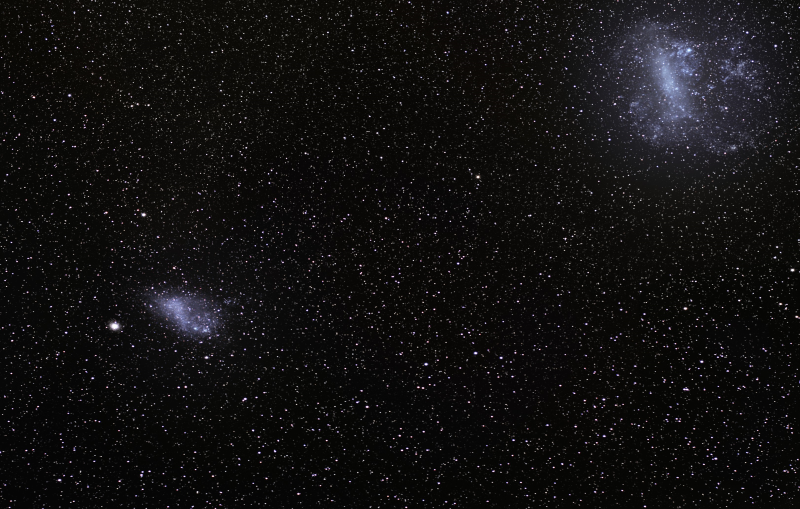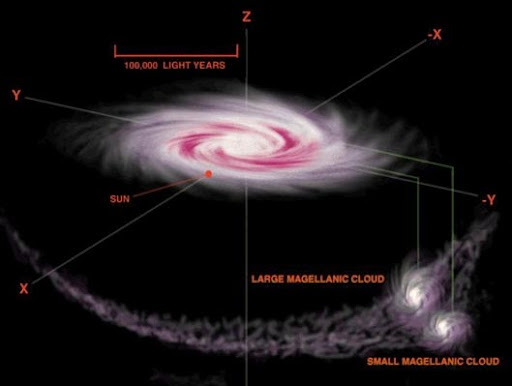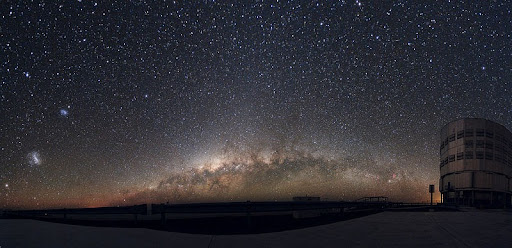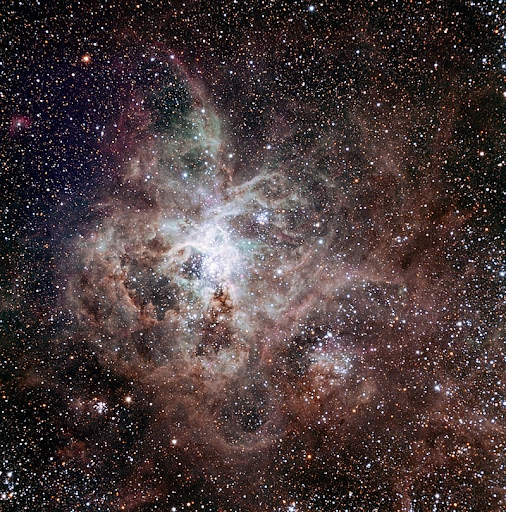Facts About the Magellanic Clouds
- The two Magellanic Clouds are also called Nubeculae Magellani. It is comprised of the Small Magellanic Cloud (SML) and the Large Magellanic Cloud (LMC).
- The Small and Large Magellanic Clouds are satellite galaxies of the Milky Way. Because of that, they are believed to be orbiting the Milky Way galaxy.
- The Milky has about 50 satellite galaxies and the Large Magellanic Cloud is the largest of them. And by largest, that means about 1/100th the Milky Way’s size.
- Despite the relative proximity of the two clouds to each other, the Small Magellanic Cloud is about 35,000 light-years farther away from Earth.
- It was once commonly accepted that the Magellanic Clouds were in orbit around the Milky Way Galaxy. However, new evidence shows their relative speed might be too high for that to be the case.
- As one might guess, the Magellanic Clouds are comprised mostly of different gaseous elements. That means the presence of metallic elements is greatly diminished.
- Gravity affects the Magellanic Clouds when they pass by the Milky Way, and it causes their shapes to distort. The same effect occurs on the outer edges of the Milky Way itself.
- Some researchers believe the Small Magellanic Cloud was once a single galaxy. The galaxy that spawned the Large Magellanic Cloud collided with it to form the cosmic patterns that exist today.
- The Tarantula Nebula is part of the Large Magellanic Cloud. It is one of the most active star-birthing regions visible to man. Gas and dust are highly compressed in the area. Also, this site saw a supernova explosion in 1987.
Quick Review: The Local Group

Our solar system, together with many other star systems, is part of the Milky Way galaxy. However, our galaxy is not the only one in the entire universe. We are part of a neighborhood of galaxies called the Local Group.
There are more than 30 galaxies in the Local Group. They are spread over a region that is about 10 million light-years across. The two largest and most massive galaxies in this cluster are the Andromeda Galaxy (M31) and the Milky Way. Both of them have satellite galaxies. These are smaller galaxies that orbit around the bigger ones.
M32 and M110 are two of the most notable satellite galaxies of the Andromeda galaxy. Meanwhile, the two largest satellites of the Milky are known together as the Magellanic Clouds.
Did You Know?
The Andromeda Galaxy is approaching the Milky Way. Because of that, astronomers believe that they may collide in the far future—about 4.5 billion years from now. This collision will form a giant elliptical galaxy which will likely be called Milkomeda or Milkdromeda.
The Magellanic Clouds

The Magellanic Clouds are a pair of dwarf galaxies that are satellites of the Milky Way. Just like our galaxy, they are also a part of the Local Group. As seen in our sky, these two galaxies are about 21° apart in the night sky. But if we translate that to their true distance, they are actually about 75,000 light-years away from each other.
The clouds are comprised of two regions known as the Large Magellanic Cloud (LMC) and the Small Magellanic Cloud (SMC). They were named after Ferdinand Magellan. He was the Portuguese navigator who led the first expedition to sail around the world.
Both the LMC and the SMC are irregular galaxies. They also show some hints of a bar structure. The LMC may have been once a spiral but now it only has one spiral arm. It is believed that the Milky Way’s pull may have been responsible for its disrupted form. Because of its unique structure, the LMC became the prototype of the Magellanic spiral type of galaxy.
Sometimes, the Magellanic Clouds are called spiral galaxies as opposed to irregular galaxies. Depending on where we are on Earth, we can readily see them in the night sky under favorable conditions. Observers from the southern hemisphere can see both structures with the naked eye. However, they are not observable in most places up north.
Large Magellanic Cloud Profile

Designation: LMC
Type: Disrupted Barred Spiral
Diameter: 14,000 lightyears
Distance: 163,000 lightyears
Mass: 10 billion solar masses
Constellation: Dorado & Mensa
Discovery Date: First described in 964 A.D.
Approximate Number of Stars: 30 billion
The LMC is one of the closest galaxies of the Milky Way. Though it is a satellite galaxy, it is the fourth largest galaxy in the Local Group. It is around 14,000 light-years across. Take note that one light-year is roughly 6 trillion miles (9 trillion km). If we multiply 6 trillion miles by 14,000, we can get a sense of how really big the LMC is!
Still, the LMC is dwarfed by the three biggest galaxies in the Local Group. The first is the Andromeda Galaxy which has a diameter of about 220,000 light-years. Next is the Milky Way (about 100,000 light-years) and the third is the Triangulum Galaxy (about 60,000 ly).
The shape of the LMC has undergone some changes over time. A bar was observed from it, but it was off-center. Because of that, it is considered a disrupted barred spiral galaxy. This made scientists believe that, most likely, it was a barred dwarf spiral galaxy in the past.
The current warped form of the LMC is the result of tidal interactions it has with the SMC. The Milky Way also influences it in some way.

There are more than 30 billion stars in the LMC. It is host to the most active site of star formation in the Local Group—the Tarantula Nebula. This rich starfield is abundant in giant and supergiant stars. Aside from that, it also has hundreds of star clusters and planetary nebulae.
The LMC is located more than 160,000 light-years from us. It measures about 10° in the night sky, appearing more than 20 times as big as a full moon. We can spot it in the constellations of Dorado (the Swordfish) and Mensa (the Table Mountain). About 2.4 billion years from now, it is expected to smash into our galaxy.
Small Magellanic Cloud Profile

Designation: SMC
Type: Dwarf Galaxy
Diameter: 7,000 lightyears
Distance: 197,000 lightyears
Mass: 6.5 billion solar masses
Constellation: Tucana & Hydrus
Discovery Date: late 1400s
Approximate Number of Stars: 3 billion
The SMC is estimated to be 7,000 light-years across. Though it is more than 190,000 light-years away from us, it is one of our galaxy’s closest neighbors. At that distance, it is among the most distant objects that we can see with the unaided eye. It simply looks like a hazy patch in our night sky.
This dwarf galaxy has eight times the apparent diameter of the Moon. Because of that, it also occupies a bigger part of the sky. It straddles the southern constellations of Tucana (the Toucan) and Hydrus (the Male Water Snake). Though it is mostly seen in the southern sky, observers south of 15° north can also take a glimpse of it. Its pair, the LMC, lies 20° east of this galaxy.

The SMC is as massive as 6.6 billion Suns. It is a rich field of star formation and it contains many X-ray binaries. Though it is difficult to determine the exact number, estimations reveal that there are roughly 3 billion stars in this galaxy.
Scientists believe that the SMC may have been once a barred spiral. However, the Milky Way’s influence might have made it irregular. Also, there is evidence of tidal interaction between it and the LMC. Both are enveloped in neutral hydrogen. Aside from that, they are connected by a bridge of gas (Magellanic Bridge) where stars also form.
History and Naming

Early peoples would use the Magellanic Clouds as navigational tools since they were steady in the sky. They could easily be recognized too. In fact, there is evidence of discussion of the said pair of galaxies as far back as the first millennium.
In 964, a Persian astronomer called Al Sufi was almost certainly describing the LMC. He mentioned it in his work called Book of Fixed Stars.
Two Italian explorers were the first Europeans to observe and describe the Magellanic Clouds. Their discovery was made in the late 1400s. Within several years, other Europeans were using the clouds to aid in sea travel.
Ferdinand Magellan himself, for whom the clouds were named, used the structures to help him circumnavigate the world in the early 1500s. However, it wasn’t until some time later that the cosmic clouds were renamed after the famed explorer.
Before that, in 1603, Johann Bayer called them nubecula major and nubecula minor in his Uranometria. Nicolas-Louis de Lacaille called them the Large Cloud and the Small Cloud, but in French (le Grand Nuage and le Petit Nuage).
Measurements of the Magellanic Clouds came around the early 1900s. In 1912, American astronomer Henrietta Leavitt measured the Cepheid variables in the SMC. Danish astronomer Ejnar Hertzsprung used those data on the said variable stars to estimate how far the Magellanic Clouds are. Many more studies followed which now give us a closer estimate of their distances.
Ferdinand Magellan

From 1519 to 1522, Ferdinand Magellan made history as the captain of the first fleet that circumnavigated the world. This voyage involved 270 men and five ships. On their journey, they discovered the Strait of Magellan and many other things.
Together with Magellan was his chronicler, Antonio Pigafetta. One of his most important notes mentioned the LMC and the SMC. He described them as two separate areas where stars congregated together, just like two nebulae.
Before they were given official names, different sources called the Magellanic Clouds differently. Sailors in the past called them the Cape Clouds, a name that stuck for a long time. At the time, written accounts of the said celestial objects were limited, until the Magellan exploration. Their observations provided great sources for authors and other explorers. Because of that, they were named after the Portuguese sailor.
Curious Connections

The two dwarf galaxies, LMC and SMC, are linked together by a stream of hydrogen called the Magellanic Bridge. It is like a stellar bridge since stars from the SMC are pulled towards the LMC. Some scientists think that the two regions may have been a part of a single galaxy in the past. Still, there is no way to be certain.

The cosmic structure of the Magellanic Clouds is so close to our own Milky Way Galaxy that the clouds actually feed the Milky Way gas and dust. We can see it in a structure called the Magellanic Stream. This stream of gas extends from the Magellanic Clouds to the Milky Way’s galactic south pole. As seen on Earth, this tail stretches at least 150° in the southern sky.
It is also possible that the clouds may eventually collide and merge with our galaxy.
Characteristics, Composition, and More

When viewed from the southern hemisphere, the Magellanic Clouds seem as if they are disjointed pieces of the Milky Way that are floating through space. However, the vast distances at play cause that illusion.
For a long time, the Magellanic Clouds were the closest cataloged galaxies to the Milky Way. That changed when the Sagittarius Dwarf Elliptical Galaxy was discovered in 1994.
The LMC is about 163,000 light-years from Earth while the SMC is 197,000 light-years away. For a reference scale, the entire Milky Way Galaxy has a diameter of 100,000 light-years. With that said, they lie very far from us, at a distance bigger than the galaxy where we belong.
Up until recently, the Magellanic Clouds were assumed to orbit the Milky Way at relatively constant distances. However, the LMC and the SMC are currently closer to our own Milky Way than they have ever been.
The relationship between the three galaxies is starting to seem much more complex. Tidal interactions between these major sources of gravity have taken their toll, and the gases collected from the clouds by the Milky Way are only strengthening the connection.
Both dwarf galaxies are rich fields of gas and dust, especially the LMC. Because of that, they give birth to a lot of stars. They are also rich X-ray sources.
In 1987, a supernova called SN 1987A occurred in the Large Magellanic Cloud. It was 168,000 light-years away from our planet, making it the closest modern supernova event to us. It was discovered at the Las Campanas Observatory in Chile. At the time, SN 1987A reached its brightest with an apparent magnitude of 3.
The Magellanic Clouds vs the Milky Way

The Magellanic Clouds and the Milky Way are very different from each other. Aside from the size, distance, and position in the Local Group, they also have distinct concentrations.
There are two primary differences between the Magellanic Clouds and the Milky Way. The first is that the clouds are more gas-rich, specifically with helium and hydrogen. They also have far less metal than the Milky Way.
In the case of the SMC, the dwarf galaxy only contains 25% of the metal concentration found in the Milky Way. The abundance of pressurized gases and the relative lack of heavy metals cause new stars to form quite rapidly within several notable nebulae. There are also stars in the clouds that have been around for billions of years.
Notable Objects in the Magellanic Clouds
Just like our own galaxy, the Magellanic Clouds also contain a lot of interesting deep-sky objects. Below are some of them.
Tarantula Nebula (30 Doradus)

The Tarantula Nebula is named so because of its web-like structure. Bring the largest H II region in its galaxy, this active starburst field is the most defining region of the LMC. It was discovered by Nicolas-Louis de Lacaille around 1751 to 1753 during his stay at the Cape of Good Hope.
Since it is located in the constellation of Doradus, it is also called 30 Doradus and Doradus Nebula. It lies about 160,000 light-years away from us. Even with that distance, it still appears relatively bright to us, with an apparent magnitude of 8. In fact, it looks as though it is as close as the Orion Nebula which is in the Milky Way.
NGC 2070 (Caldwell 103)

NGC 2070 is a massive open cluster at the center of the Tarantula Nebula. Though it is just a part of the nebula, it is sometimes confused with the nebula itself. It has an apparent magnitude of about 7.25 and lies roughly 157,000 light-years away.
The most active region of NGC 2070 is called R136. This condensation is home to a lot of massive stars including R136a1.
LHA 120-N 11

LHA 120-N 11 is an emission nebula located in the LMC. This complex looks like it is made of glowing pink clouds. It is the second-largest H II region in the LMC after the Tarantula Nebula.
This large region of stars is also known as N11, and sometimes the Bean Nebula. It forms a large bubble with different distinct regions. It has the N11A (Rose Nebula) in the northeast portion and the N11 B in the northern part. The latter, also called NGC 1763, is the brightest part of the N11.
NGC 1850

NGC 1850 is a super star cluster which means it is a very young and massive open cluster. Though it is an open cluster, the stars are distributed just like the bigger globular clusters, but with young stars. It was discovered in 1826 by the Scottish astronomer James Dunlop.
This star cluster has a radius of around 16 light-years and is roughly 42,000 times as massive as the Sun. It contains a lot of main-sequence stars. Most of them have a reddish color while about a quarter are hot blue.
NGC 1850 is surrounded by nebulosity. It is located 168,000 light-years from the solar system. It lies in the bar of the LMC, in the Dorado constellation.
N81

N81 is a young star cluster in the SMC. This newborn star cluster is surrounded by a glowing cloud of dust or nebula.
NASA’s Hubble Space Telescope discovered that this stellar nursery has a lot of white-hot stars. These stars are losing mass which sends shock waves to the nebula. The SMC has a very different chemical composition than the Milky Way. Because of that, peering at the N81 helps give scientists a clue about what star formation is like in galaxies other than our own.
Sources:
https://www.britannica.com/topic/Magellanic-Cloud
https://www.planetsforkids.org/galaxies/magellanic-clouds.html
https://en.wikipedia.org/wiki/Magellanic_Clouds
https://en.wikipedia.org/wiki/Large_Magellanic_Cloud
https://en.wikipedia.org/wiki/Small_Magellanic_Cloud
(https://www.universetoday.com/147875/a-history-of-the-magellanic-clouds-and-how-they-got-their-names/)
Image Sources:
Local Group: https://upload.wikimedia.org/wikipedia/commons/thumb/f/fe/Local_Group.svg/683px-Local_Group.svg.png
Magellanic Clouds:
https://upload.wikimedia.org/wikipedia/commons/thumb/4/41/Magellanic_Clouds_%E2%80%95_Irregular_Dwarf_Galaxies.jpg/800px-Magellanic_Clouds_%E2%80%95_Irregular_Dwarf_Galaxies.jpg
Large Magellanic Cloud:
https://upload.wikimedia.org/wikipedia/commons/thumb/4/4a/Large_Magellanic_Cloud_rendered_from_Gaia_EDR3_without_foreground_stars.png/800px-Large_Magellanic_Cloud_rendered_from_Gaia_EDR3_without_foreground_stars.png
Closer look at the LMC:
https://www.nasa.gov/sites/default/files/styles/full_width_feature/public/images/721196main_721020main_heic1301a_full.jpg
Small Magellanic Cloud:
https://upload.wikimedia.org/wikipedia/commons/thumb/8/81/Small_Magellanic_Cloud.png/800px-Small_Magellanic_Cloud.png
Closer look at the SMC:
https://www.nasa.gov/sites/default/files/styles/full_width_feature/public/images/738999main_pia16884-full_full.jpg
LMC and SMC:
https://cdn.eso.org/images/thumb700x/ATs_Magellanic_Clouds_hires-CC.jpg
Ferdinand Magellan:
https://upload.wikimedia.org/wikipedia/commons/9/9c/Ferdinand_Magellan.jpg
Magellanic bridge:
https://upload.wikimedia.org/wikipedia/commons/e/e3/Bridge_of_stars_ESA22359297.gif
Magellanic stream:
https://apod.nasa.gov/apod/image/9808/lmcstream_csiro.jpg
Supernova 1987A:
https://upload.wikimedia.org/wikipedia/commons/thumb/0/0a/Eso0708a.jpg/800px-Eso0708a.jpg
Magellanic Clouds vs the Milky Way:
https://upload.wikimedia.org/wikipedia/commons/thumb/5/59/Panoramic_Large_and_Small_Magellanic_Clouds.jpg/800px-Panoramic_Large_and_Small_Magellanic_Clouds.jpg
Tarantula Nebula:
https://upload.wikimedia.org/wikipedia/commons/thumb/8/80/Tarantula_Nebula_TRAPPIST.jpg/800px-Tarantula_Nebula_TRAPPIST.jpg
NGC 2070 (Caldwell 103):
https://upload.wikimedia.org/wikipedia/commons/thumb/b/b9/NGC_2070_ESO.jpg/800px-NGC_2070_ESO.jpg
LHA 120-N 11:
https://upload.wikimedia.org/wikipedia/commons/thumb/0/0b/N11_%28Hubble%29.jpg/800px-N11_%28Hubble%29.jpg
NGC 1850:
https://upload.wikimedia.org/wikipedia/commons/thumb/d/d3/NGC_1850.jpg/800px-NGC_1850.jpg
N81:
https://stsci-opo.org/STScI-01EVT9TWBPPCZ709EHBXDCTVH2.jpg